Middle School Teams
Aldine Young Women’s Leadership Academy, Aldine ISD
"Flame-Tastic Four"
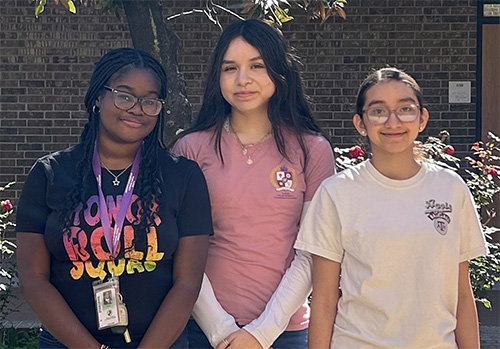
PROJECT DESCRIPTION:
Climate changes are constantly occurring and wildfires are becoming an increasing issue in the country and all over the world. Our solution to this is a fire detection system through drones. Wildfires tend to occur in vast areas such as forests which makes it difficult to put them out. Our solution is a drone with a GPS system and an additional four sensors: A CO2 sensor, an infrared sensor, a heat sensor and a smoke detector. These sensors are used to determine the possibility of a fire in a location. Having this information, the drones can then send signals to nearby fire departments so they can prevent the potential fire from spreading. We hope to prevent these fires from happening and destroying communities and homes and taking lives through this invention.
Ann Richards School for Young Women Leaders, Austin ISD
"Wildfire Wranglers"
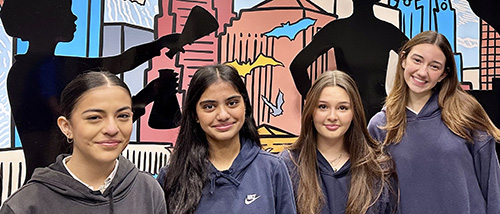
PROJECT DESCRIPTION:
Our climate is changing across the world which is causing an increase in devastating wildfires. Our team, Wildfire Wranglers, is developing an innovative system designed to protect homes and communities from fire destruction. We are creating a sprinkler system that activates when the attached thermometer detects high temperatures and releases Barricade Gel. The Gel forms a protective barrier on the roof and entire exterior of the home. In addition to the sprinkler system, we are developing fire retardant beads designed with a filament that melts at high temperatures, releasing the fire retardant to help control and extinguish fires on the ground around the property. Our approach helps safeguard homes and surrounding areas against the threat of wildfires.
Balch Springs Young Women’s STEAM Academy, Dallas ISD
"F.O.U.R"
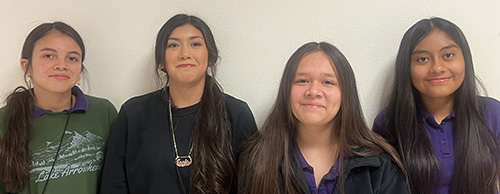
PROJECT DESCRIPTION:
The SolarFlare Solar Power Charger is designed to harness renewable solar energy to provide a portable, eco-friendly solution for charging electronic devices. Using the engineering method, our team first identified the problem: the need for a sustainable, off-grid charging solution for devices like smartphones. We started by researching solar panel technology and power storage options to ensure efficient energy conversion. Next, we designed a compact, lightweight charger that integrates high-efficiency photovoltaic cells to capture sunlight, converting it into direct current (DC) electricity. The design includes a built-in charge controller to manage power flow and prevent overcharging, as well as a rechargeable battery to store energy for use when sunlight is not available. We tested and optimized the system to maximize energy output, focusing on improving solar panel placement and adjusting battery storage capacity. Finally, we built a user-friendly device with a USB port for easy connection to a variety of devices. The SolarFlare is not only an environmentally-friendly alternative to traditional chargers but also a step towards reducing our reliance on non-renewable energy sources.
Irma Rangel Young Women’s Leadership School, Dallas ISD
"Downpour"
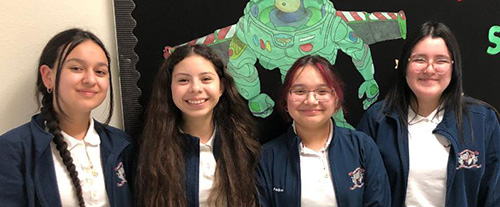
PROJECT DESCRIPTION:
Sea levels are rising by 0.17 inches per year. While this might not seem like much, in a few years, many port cities could be underwater. On top of this, droughts are becoming increasingly common, which in the long run will cause food shortages and fires, as we currently see in places like California. These issues are mainly caused by climate change, specifically global warming. To combat both drought and sea levels rising, we designed a type of funnel to collect water from melting icebergs and glaciers. Collecting the freshwater will decrease the amount that sea levels rise; additionally, the water the funnel collects will be distributed to areas affected by drought to help irrigate land. Most plants need freshwater because saltwater is known to dehydrate and poison plants, which is why we chose to collect water from melting icebergs and glaciers. We can save our coastal cities and our food supply with our Glacier Flow invention!
Young Women’s STEAM Research and Preparatory Academy, El Paso ISD
"Blaze Breakers"
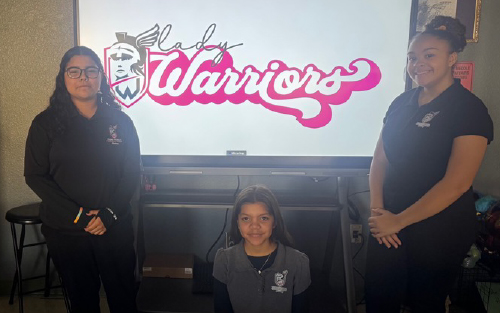
PROJECT DESCRIPTION:
The purpose of our project is to reduce damages caused by wildfires by analyzing materials that are used to build houses. We were inspired by the recent wildfires in California. Our goal is to improve fire resistance/retardation to in turn, reduce devastation. The project is mostly research based, to include why, when, and where fires commonly start. The experiment we conducted was to find out which housing material is more fire resistant/retardant. Once we conducted our experiment, we organized and studied our results, coming up with a conclusion of which housing material is most durable and most likely to survive wildfires.
Young Women’s Leadership Academy, Fort Worth ISD
"The Frost Fighters"
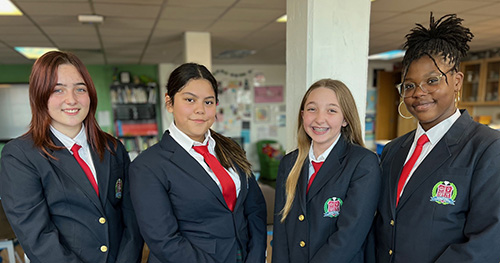
PROJECT DESCRIPTION:
We, the Frost Fighters, are addressing the issue of icy roads. We have created a solar powered, cost effective, and efficient device that distributes a chemical that lowers the freezing point of water onto the roads. We have both created a model of this device and tested several chemicals to determine which yields the best results. Our device can be attached to the guardrails along the highways. It has a container holding the chemical behind the guardrail, and inside is a solar powered water pump connected to a solar panel on top of the container. The water pump is connected to a flexible tube, which runs out the side of the container into a PVC pipe with holes at intervals. The water pressure forces the chemical through the holes onto the road, coating it. Our invention could help highways become safer during cold weather.
Young Women’s College Preparatory Academy, Houston ISD
"The C.V.M.C. Equilibreans"
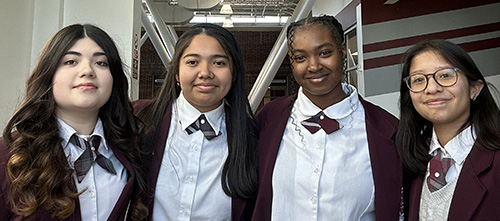
PROJECT DESCRIPTION:
Project R.F.D. capitalizes on stabilizing the vulnerability sites of residencies during natural disasters that cause flooding, not entirely removing such effects but lessening them; we propose a structured mitigation process, in its most practical form. The sectional water equilibrean, in its integration of a mechanical sustaining unit, automatic execution, data analysis receptors, manual control upon preferences, and a safety switch in case of emergency, our product addresses the most probable instances to continue to serve its purpose despite any circumstances. The sectional water barrier is a customizable and foldable aluminum barrier, intended for foundations, windows, and doors, which is sustained by a linear actuator that processes data analytics collected from our data receptors (placed around bodies of water), and thereupon executes automatic safety measures which may be regulated (per its heightening setting); in its default compact figuration, the sectional water barrier may be easily installed by oneself and stored or left in its designated place.
Talkington School for Young Women Leaders, Lubbock ISD
"The Carjackers"
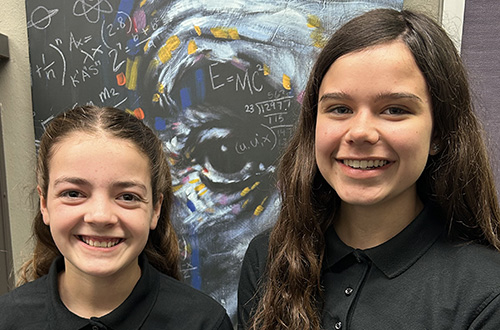
PROJECT DESCRIPTION:
Our project, W.I.M.M.P.S. (Water Induced Mechanical Malfunction Preventative System), aims to reduce the amount of civilians trapped inside of cars during severe floods. We’ve developed a prototype of a car door that consists of two main functions: a water-sensing door lock and a window mechanism that operates in two different ways. The water-sensing door lock serves the purpose of ensuring that when water disrupts a car’s electrical system, it doesn’t keep the door locked. When water is sensed, it automatically unlocks the car door so that the passengers can exit if necessary. The door’s window acts as a “Plan B” with both an electrical and mechanical mechanism to roll it down. By enabling both of these systems, our project can help passengers safely escape flooded cars.
Young Women’s Leadership Academy, Midland ISD
"Hail Heroes"
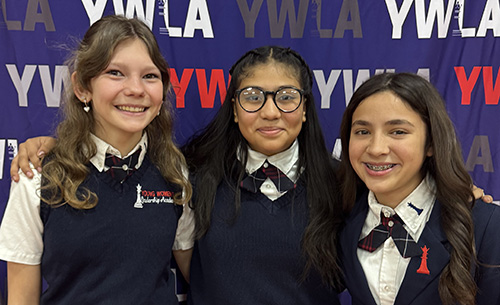
PROJECT DESCRIPTION:
NOAA Severe Weather estimates that $1 billion worth of damage is caused by hail annually. Hail can range from pea sized to grapefruit sized, which can be extremely damaging, if not deadly. Our product aims to protect one of the most expense assets you own–your car. Whether you are parked or caught out on the road, we have a solution! We have created a multi-layer car cover that differs from what is currently on the market because it has an inflatable layer to repel the biggest hail. It’s constructed using materials such as reusable plastic, mattress foam, and blow up mattress material. It’s easy to store in the back of your car, so you can take it wherever you need, whether it’s a road trip, or it’s just sitting in your garage, our product has you covered, literally.
Young Women’s Leadership Academy, Ysleta ISD (El Paso)
"Eva-Lutions"
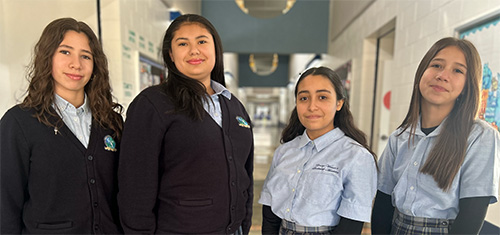
PROJECT DESCRIPTION:
Quick and effective action is essential when these natural disasters occur to save lives and reduce harm. Our project aims to design a robot that can go into the field during these disasters to help locate people and animals needing assistance. This robot’s main function would be to detect the presence of individuals in dangerous situations, enabling first responders to prioritize rescues without putting themselves in unnecessary danger. By identifying people needing help, the robot would allow emergency teams to work faster and more safely, reducing the time it takes to save lives. Additionally, the robot’s capability would provide peace of mind, knowing that fewer lives are at risk in the immediate aftermath of a disaster.
High School Teams
Aldine Young Women’s Leadership Academy, Aldine ISD
"Freeze Barrier"
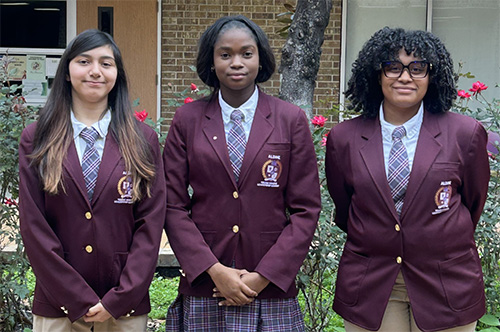
PROJECT DESCRIPTION:
Our STEM project this year is a pipe that is able to withstand freezes which have affected homes and families with their pipes bursting due to the harsh weather. Our pipe consists of layers such as the inner layer being pex pipe and outer layer being metal pipe. The pex pipe is able to withstand harsh temperatures and is durable, while the metal pipe is used to be backed up if the pex pipe cracks. We also have a temperature probe placed in the pipes that is able to touch the water within the pex pipe to sense the temperature and warn the homeowner of when the water within the pipe is near freezing. This will prevent the increase in pipe bursts in years to come by creating a protected pipe that is less vulnerable to bursts.
Ann Richards School for Young Women Leaders, Austin ISD
"D.D.I.S. (Drone Delivery Information System)"
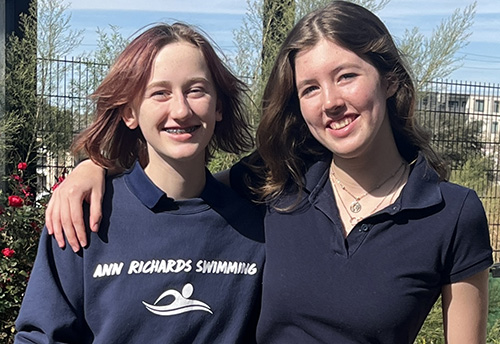
PROJECT DESCRIPTION:
Our Team D.D.I.S (Drone delivery information system) hopes to provide a tool for first responders to utilize during flood relief. The drone will convey messages to the public on flood safety and procedures through real-time communication, cameras, and GPS tracking. We will use this drone to eliminate panic while bridging the communication gap, which is essential in these dangerous situations. To communicate practically, the operator will speak through a speaker to the people in distress, and the people will communicate through gestures that the camera on the drone can see. This will inform people of dangerous situations, medical availability, and safety
procedures and collect information such as their location and needs.
Balch Springs Young Women’s STEAM Academy, Dallas ISD
"The Misfits"

PROJECT DESCRIPTION:
Our team’s response addresses the significant weather challenges faced by Texas, particularly during extreme winter conditions. These conditions have strained the state’s power grid and increased the risk of fatalities, such as hypothermia, among families. The tragic winter storm of 2021 highlighted the consequences of power grid failure, resulting in over 200 fatalities due to inadequate insulation and the failure of conventional heating systems during power outages. To combat this issue, we are developing a prototype called the ThermoWall 3000. This innovative in-wall insulation system is specifically designed to handle extreme cold. It features self-deploying insulation technology that activates during power outages, adding an extra layer of insulation between the wall studs and enhancing heat retention to help maintain indoor temperatures. The goal of the ThermoWall 3000 is to improve home safety and comfort during severe weather events, thereby reducing the risk of cold-related health issues and fatalities. This proactive solution aims to safeguard residents against the harsh realities of winter storms, ensuring their well-being in Texas homes during challenging conditions.
Irma Rangel Young Women’s Leadership School, Dallas ISD
"STEAM Stars"
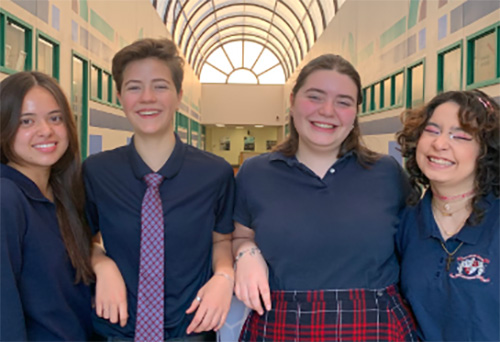
PROJECT DESCRIPTION:
Our team, the STEAM Stars, is developing a living walkway. The living walkway is a system that assists in alerting people of potential flooding, while also working to reduce flooding! It combines sustainability and aesthetics with stormwater management to create a multifunctional pathway that makes the community better equipped when dealing with storms. Using permeable pavers, water absorbing plants, the living walkway reduces the amount of runoff that occurs in urban areas during heavy rainfall and helps minimize the risk of flash flooding. Additionally, the living walkway is equipped with real-time flood sensors installed along the edging, which will alert the community to potential flood risks.This information helps communities better prepare for and respond to extreme weather events.
Young Women’s STEAM Research and Preparatory Academy, El Paso ISD
"Gel Force"
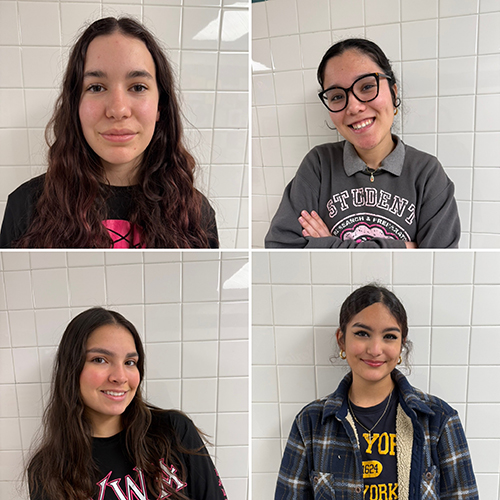
PROJECT DESCRIPTION:
This project focuses on the development and deployment of hydrogel-infused sand (H.I.S.) as an innovative solution to combat extreme environmental challenges in arid and semi-arid regions. H.I.S. is designed to enhance water retention in sandy soils, mitigating the effects of flooding, droughts, and dust storms while improving agricultural viability and ecosystem sustainability.
Young Women’s Leadership Academy, Fort Worth ISD
"Team PowerUP"
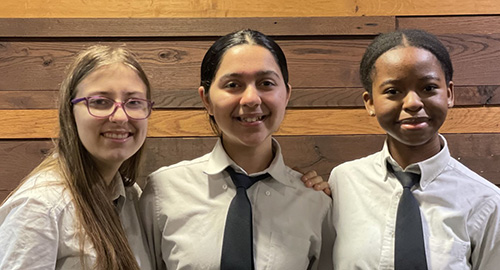
PROJECT DESCRIPTION:
Team PowerUP’s goal is to create electronic cellular support for rural areas with limited power infrastructure. Our focus is on assisting disaster recovery and empowering citizens facing challenges such as lack of lighting, communication, and location services that the use of cell phones can offer. Without electricity, these services are useless. Our team has researched a method, and designed a product to utilize rural roadways to address this issue. We plan to harness vibrations from passing vehicles in order to charge small voltage batteries and create charging stations accessible to anyone in emergency situations, particularly during power outages.
Young Women’s College Preparatory Academy, Houston ISD
"Genius Gems"
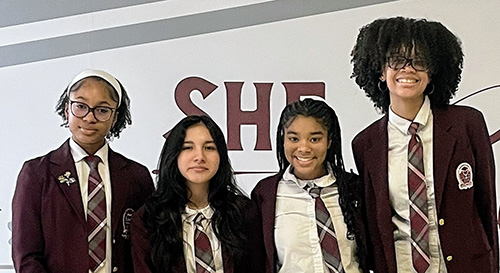
PROJECT DESCRIPTION:
The Eco-Barrier Filtration System by the Genius Gems enhances community resilience against natural disasters. Designed to address pollution during Houston’s frequent floods, this innovative system uses a stainless steel mesh to trap large debris and layers of natural materials like activated charcoal and sand to filter harmful chemicals. A programmable microbit monitors water flow and alerts users when maintenance is needed. By mitigating pollution in storm drains, this solution strengthens disaster response and recovery efforts while promoting a cleaner, more sustainable environment.
Talkington School for Young Women Leaders, Lubbock ISD
"The STEAM Engines"
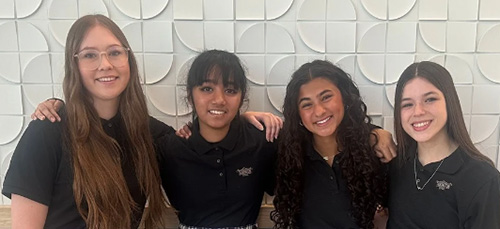
PROJECT DESCRIPTION:
The recent destruction caused by hurricanes inspired us to construct a solution to provide relief for the affected communities and aid in mitigating these catastrophic and disastrous storms. We researched the damage Naples, Florida suffered from the recent hurricanes Milton and Helene and mapped out the communities that need the most attention. From there, we created a design that harnesses the flood waters that fill the streets by accessing the water through storm drainage channels and using this water to power a hydroelectric pitchback water wheel. This water will power the wheel, which can generate electricity for homes experiencing power loss in the community. We depicted the functions of our mechanism through an architecturally and structurally accurate online modeling animation of our water wheel.
Young Women’s Leadership Academy, Midland ISD
"Lifesavers"

PROJECT DESCRIPTION:
In the aftermath of natural disasters, like hurricanes and floods, residual water can be electrified due to broken power lines, endangering thousands of people. To address this issue, we developed AquaAlert, a buoy that detects the presence of electricity in water and signals its presence using a sensory indicator. We identified electrified water as a hazard during recovery efforts through the engineering method and researched how impurities in post-disaster water enable electrical conduction. Our initial prototype utilized LED lights and a voltage sensor programmed through an Arduino board to detect electrical signals and indicate what it detects through the LEDs. Initial detection failed due to insufficient voltage detection, but we were able to fix this through the implementation of a voltage amplification circuit. AquaAlert provides a viable solution to prevent injuries from electrified water, paving the way for safer hurricane recovery efforts. Further improvements, like stronger sensors and a larger size, could increase its adaptability and improve post-disaster safety for communities.
Young Women’s Leadership Academy, San Antonio ISD
"ALAS"

PROJECT DESCRIPTION:
Throughout the decades, homes near the shoreline have experienced constant damage from relentless hurricanes, and other flood-related disasters, leaving many families stranded in times of need. Part of this damage occurs due to the poor construction put into these homes. However, this problem will soon come to an end with the creation of Aqua Architecture. Aqua Architecture is a cunning new design for homes that battle against rising sea levels during natural disasters. The structure of these homes consists of elevation technology and water-resistant materials that make the buildings effective and adaptive. This ensures that when tensions rise in the environment, so will the homes.
Young Women’s Leadership Academy, Ysleta ISD (El Paso)
"Fantastic Four"

PROJECT DESCRIPTION:
Imagine a flood-prone community, where every storm brings the fear of rising waters, threatening homes, livelihoods, and the safety of families. The solution we’ve designed offers protection to these vulnerable areas with an innovative, L-shaped storm surge barrier. Inspired by the durability of Swedish storm barriers and the flexibility of cattle gates, this system is solar-powered and opens to withstand the force of floodwaters, while strong enough to support the weight of a car passing over it if deployed early. More than just a defense mechanism, this barrier serves the community in peace and in crisis. When not in use, the solar energy it captures is funneled back into the grid, providing a clean, renewable power source to neighborhoods that rely on it. This design isn’t just about holding back water; it’s about empowering communities to withstand the growing challenges of climate change with resilience and sustainability.




